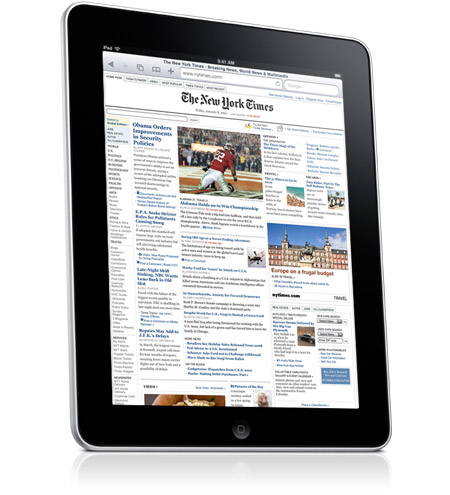The Apple iPad is primarily a device for consuming, not creating, media.
 I spent several years developing software for Microsoft's Tablet PC, only to be dismayed that the market for such software didn't evolve quickly. As a person who's switched from Windows to OS X for much of my day-to-day work and as a very happy owner of an iPhone, I had high expectations for the iPad, announced today.
I spent several years developing software for Microsoft's Tablet PC, only to be dismayed that the market for such software didn't evolve quickly. As a person who's switched from Windows to OS X for much of my day-to-day work and as a very happy owner of an iPhone, I had high expectations for the iPad, announced today.
Given the speculation that swirls around Apple products prior to their launch, and the thesis that Apple had been delaying the release of a Tablet form-factor for years in order to get things just-so, disappointment in any actual device was probably inevitable. No resolution, battery life, or input technique could keep up with the dream of a reinvention of the computer.
So what is the iPad? A slate-style Tablet PC with a 1024 x 768 resolution that runs a single app at a time. It's closer to being an iPhone than it is to being a Macbook.
Consuming media:
The iPad has some nice enhancements for iTunes. Big deal. The iPad can watch movies and TV. But it isn't widescreen. You can watch video for 10 hours on your flight from San Francisco to Tokyo. Or, I suppose, I could pack an extra battery for my laptop and do the same.
Much is being made of the iPad as a threat to the Kindle. But I've read books and magazines on 1024 x 768 slates and I'll flat-out say that it's not as nice as the Kindle experience. Multicolumn layouts do not work at that resolution. You either have unreadably narrow text in portrait mode or you switch the computer to landscape mode and have to zig-zag up and down to get the whole page. Admittedly, the iPad has 132 pixels per inch, so it's going to look great, but when you only have 768 pixels in which to fit multiple columns, individual letters just don't have the necessary resolution for long-duration reading.
Creating media:
Like all Americans, I consume a ridiculous amount of media. I have a lot of music, I watch a lot of TV, I read a lot of books, and I read a ridiculous number of magazines. Oh, and blogs, Twitter, and the occasional Website.
But I think of myself as a person who creates media. I write, I program, I take photos, I make videos. If my tin ear wasn't obvious even to myself, I'd undoubtedly make music. In this way, I am Apple's classic target market (well, the computer programming is not part of Apple's classic market, but they've figured that out in the past couple years with the iPhone).
So what does the iPad provide for media creation? Nothing.
There's no camera, either still or video. We didn't see any new ideas for iPhoto or iMovie. While Jobs showed Pages on the iPad, the tablet form-factor calls for all-new concepts for note-taking and writing. Microsoft's OneNote shows the way for note-taking, no one has ever written a decent word processor for the Tablet form factor.
To me, the lack of innovation in media creation is an enormous hole in the iPad story.
You interact with your iPad using a finger. Fingers are fine things, but they aren't pens and brushes. On the keys of a keyboard, they can fly, but not on a flat touchscreen. I've used flat touchscreen keyboards -- they suck. And the iPad has a curved back, which means that it rocks if you lie it flat and type. But lying a slate flat and typing on it is a bad user experience anyway. And holding up a slate and hunting-and-pecking is frustrating. Trust me: I've been there and done that.
The use of a finger rather than a stylus means that the iPad may not suffer from another problem, which is the parallax shift that occurs when you attempt to point precisely on a slate held at an angle. In other words, when you try to interact with a screen in the same way you interact with a clipboard, it doesn't quite work and the "doesn't quite" of it is really annoying.
The iPad has bluetooth connectivity and a stand with keyboard integration. I want that stand more than I want the iPad; it's just that I want it for my iPhone.
I assume that the 2nd or 3rd generation of iPad will move towards 1920 x 1080 resolution. Once you get to 1000 pixels, multiple-column portrait-mode reading becomes feasible. But that's obviously going to be at least a year or two away. In the meantime, I'll stick with my Motion Computing slate and dream about someone getting the tablet form-factor right.